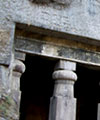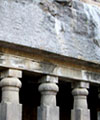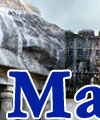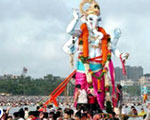| Encyclopedia of Tours and Travel to Maharashtra, featuring information on Fairs & Festivals, Wildlife, Excursion, Adventure and Weather of Maharashtra. |
 |
 |
 |
 |
 |
 |
 |
||
|
Nasik
Festival The Sinhastha Kumbhamela The origin of the Kumbh Mela One of the many precious things that arose from the depths of the troubled waters was a pot of nectar (Amrit Kumbh). Lord Vishnu, disguising himself as an enchantress ( Mohini), seized the nectar from the demons. While fleeing from the evil ones, Lord Vishnu passed the nectar on to his winged mount, Garuda. The demons finally caught up with Garuda and in the ensuing struggle, a few drops of the precious nectar fell on Allahabad, Nasik, Hardwar and Ujjain. Since then, the Kumbh Mela has been held in all these places, every 12 years. Another story is that once all the Teerthas went to Adinath Bhagwan Shankara . Following Bhagwan Shankara's order they had been to Mrutyuloka (earth) to save sinners on earth. Teerthas absolved the sinners on the earth, but were themselves saturated with others' sins . They requested Bhagwan Shankara to free themselves from sins. Shankara asked them to go and live in solitude for one year at the bank of river Godavari. Shankara promised the Teerthas that he himself, with all other Gods will also stay with them . After taking bath in the sacred water of Godavari, they will be free from the sins. Hence during the Kumbha Mela a dip in Godavari river has attained a great importance. In Shiva Purana there is a story explaining the importance of Sinhastha Kumbha Mela. Gautama Rishi got salvation of his cow-killing sin from Lord Shankara after a long penance. Then the river Ganges descended down on the earth. After some time she wanted to go back to her home place. However the Rishis and Gods gathered there and requested her to stay back on the earth for the prosperity of the earth. She agreed to stay back only after taking a promise from Lord Shankara that all the Rishis present there and all Gods will stay with her. Then only she will stay back. Gods and Rishis promised her that during the period, when Jupiter and Sun will be in the zodiac sign Leo (Simha Rashi), they will all stay on the earth. In later years , it is said , acknowledging importance of Kumbha Mela Lord Rama with his Guru Kashyap stayed and lived for one year in Trimbakeshwar. During this period he performed all the religious rites like yatra, shraddha etc near Kushavarta Why every 12 years? Gods were on Mrutyulok (earth) for twelve days. Gods twelve days are equal to 12 years for Mrutyulok . Thus Gods were on earth for 12 years with Amrut. Hence every 12 years Kumbha Mela is celebrated at the four places, where a few drops of Amrut had fallen. Where and when?
Recognizing the importance of the Sinhastha Kumbha Mela Shri Shankaracharya appealed the disciples of his Vaidik Dharma to assemble at the time of Sinhastha Kumbha Mela. Following his appeal, till now devotees, pilgrims, and people of various sects and religions gather together for Kumbha Mela. Akhadas Leaders of the different sects have arrived at a consensus to follow a specific sequence for taking bath. E.g. in Haridwar Mela, Niranjani Gosawi will take bath first and then Nirwani Gosawi will bathe. In Trimbakeshwar, first Niranjani Gosawi will take bath and after they leave Kushawarta Teertha, Nirvani Gosawi will take bath . After them the old Udasee sadhu followed by new Udasee Sadhus will take bath. The Nasik Kumbh Mela is a mammoth affair with over three and a half million people attending it. Thousands of Sadhus and holy men and millions of pilgrims immerse themselves in the holy Ramkund and Kushavarta reservoirs. The peak festival days are August 14 and 25 and September 8 and 20. During the Kumbha Mela, Nasik City and Trimbakeshwar are in a fantastic festive mood. The festive and religious mood makes people get away from their daily chores and experience the spiritual ecstacy. Kumbhamella Temples :
Kundas :
Nasik as a Holy Place :
|
||||||||||
|
||||||||||
|
||||||||||
|---|---|---|---|---|---|---|---|---|---|---|